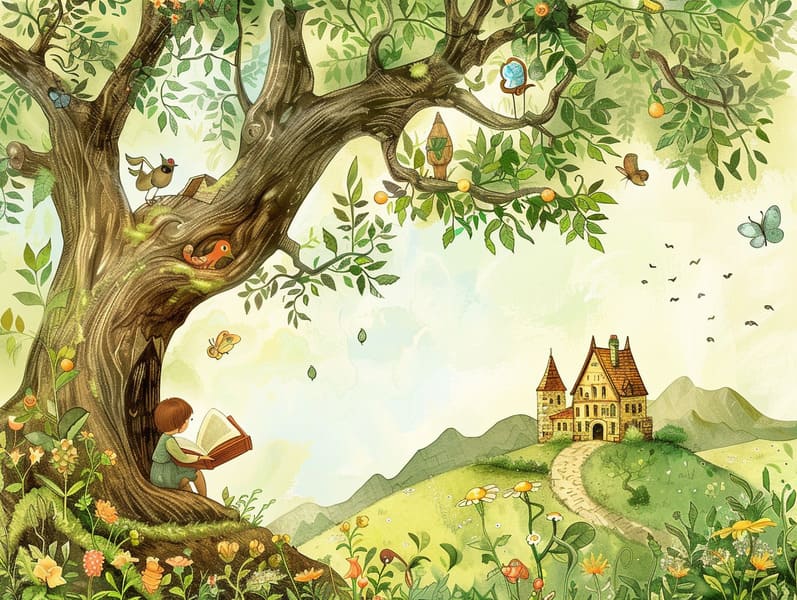
Timeless fairy tales have long histories. These tales have been whispered from one generation to the next ages before they were ever documented. They emerged from a variety of societies, including Western traditions. They were initially disseminated among older generations, often carrying themes and messages relevant to the societal norms and beliefs of the time.
Jacob and Wilhelm Grimm, Jacob and Wilhelm Grimm, were among the first to assemble many of these beloved narratives. Their published works, "Grimm's Story Collection," included classics like "Cinder Maid," "Hansel and Gretel," and "Little Snow White," which have since become hallmarks in the world of famous fairy tales. Similarly, the Danish author's whimsical narratives, such as "The Mermaid's Tale," and "The Story of the Ugly Duckling," have touched hearts worldwide, establishing their place in the pantheon of classic fairy tales.
Even though they are old, fairy tales remain as meaningful as ever, especially as children's bedtime stories. These charming stories are now available in different formats, including richly illustrated books, magical animations, and web-based fairy tales.
Their lasting appeal can be attributed to several fascinating points:
Significant Morals: Timeless fairy tales often provide important moral lessons. Stories like "The Story of the Boy Who Cried Wolf" teach the merit of integrity, while "The Tale of the Tortoise and the Hare" demonstrate the virtues of determination and unpretentiousness. These tales offer young ones clear distinctions between good and bad, molding their moral compass in a soft yet meaningful way.
Kindness and Comprehension: Classic fairy tales frequently depict individuals facing tests and troubles, provoking listeners to connect with their struggles and encourage their triumphs. For instance, "The Tale of Beauty and the Beast" highlights the merit of seeing inner beauty to understand the real character of a soul, encouraging compassion and recognition.
Cultural Knowledge: Many classic fairy tales are deeply embedded in the cultural contexts from which they sprang. Delving into these tales can provide informative snapshots into different historical contexts, building a sense of world respect and discernment.
Creativity and Imagination: The fantasy-filled elements in ancient fairy tales—spells and potions—enliven children’s imaginative ideas. These fairy tales carry readers to otherworldly realms, kindling fantasy ideas and a sense of magic that endures a lifetime.
Traditional fairy tales are not only fascinating but also teaching. They act as bewitching tools in advancing various mind and heart abilities in the young. When timeless fairy tales are recited, they foster speaking abilities by teaching new word meanings and elaborate sentence structures. This practice also cultivates listening abilities and attention span, as little ones stay focused, ready to see what happens next.
Furthermore, exploring the themes and characters of classic fairy tales can nurture problem-solving abilities and evaluative skills. Young ones are educated to discern patterns, make predictions, and grasp cause and effect. These explorations also support children articulate their thoughts and feelings, boosting their emotional intelligence.
In today’s electronic age, the accessibility of online fairy tales has made these fairy tales more reachable than ever. Online platforms and programs offer ample collections of Grimm's fairy tales that can be viewed or listened on anytime, anywhere. Fairy tales told out loud are particularly well-received, extending an charming way for young ones to immerse in these enchanting tales. Audiobooks and read-aloud videos bring characters and settings to life, often augmented by fantastical sound effects and tunes that heighten the tale journey.
The enduring charm of classic fairy tales lies in their ability to adjust to modern society while keeping their key more info morals. Contemporary revisions of these tales often present more inclusive characters and modern settings, making them understandable to today’s audience. However, the underlying themes of gallantry, kindheartedness, and justice remain unchanged, continuing to impact listeners of all ages.
Fairy tales also offer a sense of peace and predictability. They distribute a systematic narrative with a obvious beginning, middle, and end, often wrapping up with the wrap-up of conflicts and the triumph of honesty over deceit. This reliability can be relieving for the young, presenting a sense of reliability in an fluctuating world.
Classic fairy tales continue to spellbind and teach new generations, maintaining their spell and relevance in modern society. As children's bedtime stories, they allow a perfect blend of charm and understanding, sustaining moral values, empathy, and creativity. The abundance of internet fairy tales and the well-received status of fairy tales read out loud validate that these old fairy tales remain accessible to new generations.
By guarding and relating these narratives, we continue to cherish the rich tapestry of tradition and cultural heritage. Whether you are reading a vibrantly illustrated book, experiencing a internet collection, or hearing an read-aloud story, the allure of popular fairy tales is always within reach. These narratives remind us of the unending presence of stories and its ability to link us across centuries and lands.
Regardless if you are experiencing a gorgeously illustrated book, discovering a web-based library, or listening through an audio story, the mystique of traditional fairy tales is always within reach.
These narratives show us of the continued essence of narratives and its ability to hold us together across epochs and places, making a tie that delights and instructs alike.